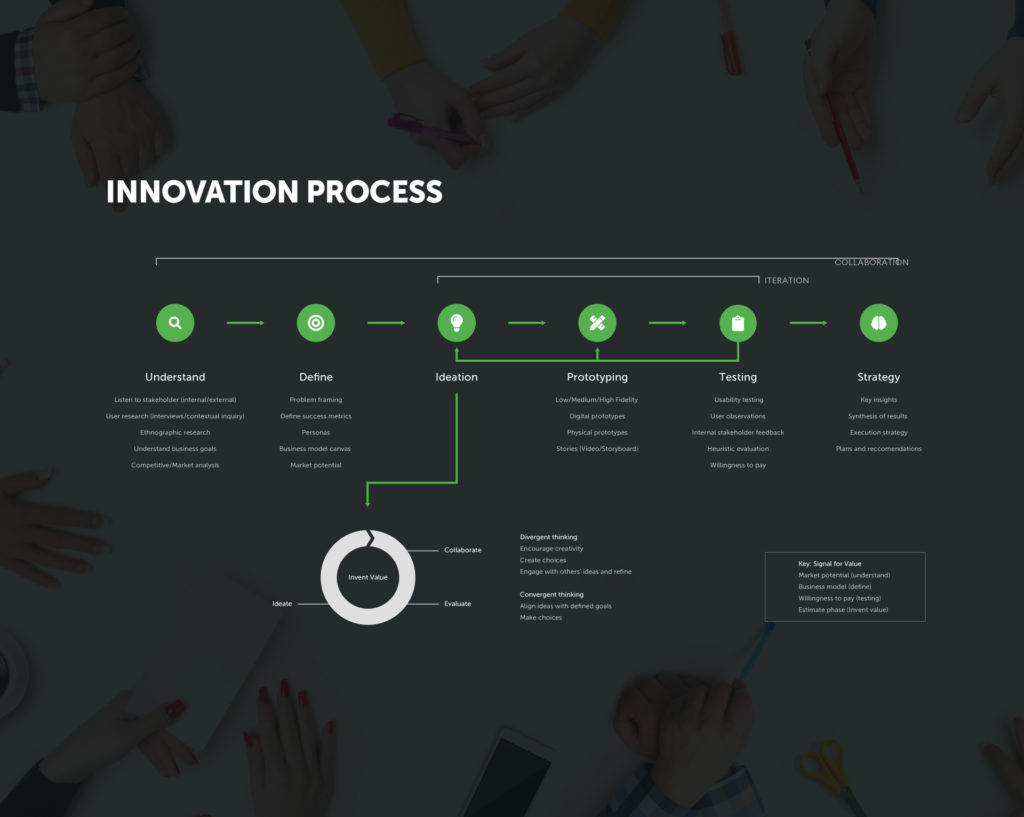Article
Interdisciplinary Strategy: Integrating Diverse Perspectives

Who is responsible for strategy?
This question has many answers. If you mean product strategy, then product managers rule the roost. Business strategy? Then, the answer might be the leadership team or C-suite.
Each branch of an organization might specialize in its own form of strategy, with the marketing team owning brand strategy or human resources identifying talent strategies. Even product-oriented roles can contribute to, and be a core component of, the evolution of successful strategies.
Here’s a breakdown of the various roles that different teams play in the development and execution of strategy:
Designers
There are multiple facets of design-oriented jobs that lend themselves to strategic thinking. Specifically, one of the most useful aspects of design thinking is empathy for users. Iris Sprague, product designer at Google, says designers are a key element in developing business strategy: “Designers have the ability to lead the company through big-picture thinking and detailed execution. Furthermore, design thinking will help your business anticipate what your customer base wants and needs. Getting your designers involved in the business strategy earlier will bring additional users and profits in the long run.” By incorporating human-centered design and design thinking into strategies across the business, you can ensure alignment and test value directly with target audiences.
In addition to designers’ expertise with empathy, communicating visually and converting concepts into tangible forms can be invaluable for prototyping and testing various strategies. As CEO and President of IDEO Tim Brown says, “When you rapidly prototype, you’re actually beginning to build the strategy itself. And you’re doing so very early in the innovation cycle. This enables you to unlock one of your organization’s most valuable assets: people’s intuitions.”
Strategy is often based on thoughts that are disconnected from the way the world actually is, Brown says. By prototyping new strategies, designers can leverage the natural intuitions and insights gained from humans interacting with ideas in the real world. Designers’ ability to create visual artifacts representing ethereal strategies can connect great strategy theory with great strategy application.
Empowering designers to contribute to strategy development can have compounding benefits, but we must still explore what separates great design strategists from novice ones. As design leader, author, and co-founder of multiple companies, David Sherwins writes in his book Success by Design: The Essential Business Reference for Designers, “Design strategists will help any design team create the why and the how that will lead to a more meaningful what. Many designers, in their design training, are not initially prepared to address what a client needs to understand around the why, and design firms can often leave a client hanging regarding the how.
A great design strategist supports the why, the how, and the what.
Great designers can think beyond the initial ask of “what do we need to make?” and “what will it look like?” to the “why is this important?” and “how will we execute on this?” Creating a deep understanding of both the problems that exist and the solutions that will create value for a client enables a designer to provide valuable assurance and counsel to a client.
Going one step further and understanding how this particular ask fits into the greater business goals of a company can enable designers to propose adjacent opportunities that can create more value for the client.

Engineers
Engineers are often viewed as existing in the space of pure execution, but this undermines the massive amount of value they can bring to developing strategy and refining it through problem-solving. Through technical expertise, attention to detail, and understanding of the steps towards realization, engineers can bring a high degree of detail to strategic implementation that can be measured, assessed, and refined as time goes on. As Guru Madhavan, Senior Scholar and Senior Director of Programs of the National Academy of Engineering, notes in his book Applied Minds: How Engineers Think, “[Engineers] see structures that aren’t apparent to the layperson, they know how to design under constraints, and they understand trade-offs.”
Strategies should produce results that are specific, measurable, attainable, relevant, and time-bound.
Ensuring strategies are grounded in tangible goals is key for evaluating their success over time. Engineers’ understanding of data and statistics makes them ideal team members to provide specific and measurable strategies. Translating company goals into corresponding data points is a skill unique to the more technically-minded members of an organization.
On top of grounding strategies, engineers are key partners in identifying how new technologies or emerging data trends change both the needs and possibilities of a strategy. Whether it’s through translating and dissecting today’s complex technology and data environments or creating the systems and processes that embody the strategy, empowered engineers are necessary for modern strategies to be successful.
Operations
Aligning your business operations around the larger strategic vision can create a more transparent culture and support a specified initiative. While one could view operations management as separate from the business strategy, this creates gaps between ideals and execution. Identifying how operations can help support a larger strategic goal and then creating measurable objectives and action plans keeps the team grounded and accountable.
On the other side, there are multiple actions operations can take to help support innovation and agility within an organization. In fact, former MIT professor Michael Hammer wrote a Harvard Business Review article entirely focused on the impact of operational innovation. One example he notes is Progressive, whose strategy to win in the insurance space revolved entirely around providing better service at lower prices through operational innovations that enabled new ways to do their work. By keeping up with trends, both in competition and new technology, one ensures that their workflow maintains parity with the rest of the market. Furthermore, identifying useful new tools as they are released enables a company to be leaders in a space, improves internal efficiency, and attracts young talent.
Finally, in supporting strategy and innovation, it is vital that there is an effective way to measure performance and progress on goals. Especially within the innovation space, understanding the impact of different initiatives is vital to ensuring money invested is seeing a return. Similarly, measurement mechanisms are key to understanding the impact of automation or validating process improvements through new tools. Without a clear method for measuring performance, strategy cannot be effectively implemented.

Marketing/Sales
Marketing is another branch where aligning with the higher-level business strategy can create valuable returns. In a research paper published by ScienceDirect exploring the impacts of aligning business strategy with IT and Marketing, authors Abdulrahman Al-Surmi et co. found a significant positive correlation between alignment and business success. Mainly, this comes in the form of targeting the right customers, helping the business grow in the ways it is trying to, and supporting the internal teams with market data and customer insights and validation.
All the benefits originate with an effective marketing strategy. It is important to note that a marketing strategy informs a marketing plan, which is the more tangible execution piece. While the strategy may not outline specific actions or channels, it contains key value propositions and defines the goals and properties of a companies’ brand. This document theoretically has a much longer lifespan than any individual marketing plan and guides the business’s growth. Thus, connecting it to the greater business strategy is key for ensuring alignment between company goals and growth.
Aside from the marketing strategy, it is important for sales and marketing to have clear and constant communication channels to the rest of the business. Being able to relay feedback from customers or clients to relevant teams and stakeholders is vital for success in the modern marketplace. Even providing executives with customer feedback based on their strategic vision can validate assumptions and pivot towards success.
Conclusion
Overall, strategy belongs to every role across an entire organization. Whether it’s designers, bringing external voices into the room, or engineers grounding goals in modern technology, each individual in an organization has key ways to contribute to its growth and direction.
Modern strategies are more alive and more networked than ever before. Whereas traditionally, a strategy was a document developed in the boardroom and shared with relevant parties, the modern business views strategy as the actions taken by each member of the organization. Strategy in a networked organization is led by culture and executed by everyone. A single marketer’s approach impacts the strategy of the organization. Looking at strategy as a living thing, influenced by each employee and every decision creates a new lens to appreciate the impact. By valuing the input of all roles, and leveraging the full company workforce, organizations can become more agile and responsive to evolving market conditions.










